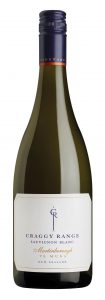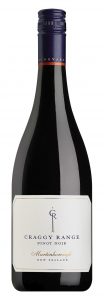This lush and faraway island off the Pacific Coast is well known as a prime on location film spot (Lord of the Rings, Game of Thrones, Xena, Warrior Princess and so forth). But in terms of wine, New Zealand is predominantly recognized for its crisp and mineral driven Sauvignon Blanc. Its extended coastline, rocky, limestone dominant soil, moderate temperatures and temperate climate is ideal for making refreshing Sauvignon Blanc with good acidity. But New Zealand also produces beautiful red wines from a range of varietals including Pinot Noir, Cabernet Sauvignon, Syrah, Merlot and Cabernet Franc.
Meet Craggy Range. Craggy Range was established in 1997 when Mary and Terry Peabody established Craggy Range on a plot of land lying east of Te Mata Peak, beneath the Craggy mountain range, in Tukituki Valley. The Peabodys chose this particular site partly because it was untouched — it had never been used for wine production before — this gave the Peabodys the opportunity to make wines that fully reflected the character of the terroir and manifested the Peabodys’ own wine conception.
Craggy Range consists of two estates: Te Muna Road (acquired in 1998) and Gimblett Gravels (acquired in 1987), two wineries: Gimblett Gravels and Giants (opened in 2003) and two vineyards: Martinborough, and Kidnappers, Hawkes Bay. These single estates have distinctive soil compositions, climate and topography that differentiate them from one another and allow them to give forth wines that are as unique.
The Craggy Range portfolio is comprised of the Appellation Collection, the Family Collection and the Prestige Collection. The Appellation Collection is made primarily for the trade industry. The Family Collection and the Prestige Collection are crafted using grapes from the Craggy Range estate vineyards. Each varietal selected was produced on soil best suited for each varietal.
The Prestige Collection, (as the name would suggest), is considered the finest of the three collections. It is produced in limited quantities from Gimbel Gravels (Le Sol and Sophia), and Te Muna Road grown grapes. Production for the Prestige Collection Chardonnay and Cabernet Sauvignon takes place at the Giants winery. This is also the site of Terroir, a French restaurant. Another winery is reserved for research and Sauvignon Blanc, Pinot Noir, Merlot and Syrah are produced here.
Craggy Range practices green and sustainable methods of wine production that exceed those required by New Zealand law. It uses organic products to cultivate grapes whenever possible so that the fruit is chemical free come harvest time. Heat generated by equipment is recycled. Natural bacteria is employed to treat winery waste water. Cool air is also captured and reused to minimize energy waste. Composting and cover crop methods are used to nourish the vines and increase soil carbon levels, while minimizing waste.

Julian Grounds, chief winemaker for Craggy Range, came to New York City in October, accompanied by Kobrand Imports (the sole distributor for Craggy Range), to introduce the Craggy Range portfolio of wines to a small group of media at Wild Ink Restaurant in Hudson Yards. Julian hails from Australia, where he was named Dux of Len Evans Tutorial and Dux of Viticulture and Oenology at Curtain University, and given the Leeuwin/Talijancich Future Leadership award. His winemaking approach reflects that of the Peabodys’ vision: to make wines from single estate grown grapes that reflect their terroir. Wild Ink was an apt choice to showcase the six wines selected. The Pan Asian fusion menu had the diversity to adapt to everything from a citrus fruit and mineral driven Sauvignon Blanc to a floral and rich berry dominant Syrah.


The first wine introduced was the aforementioned Te Muna Sauvignon Blanc, 2019 made from a combination of destemmed and stemmed, hand harvested grapes that were grown on limestone dominant soil. Fermentation takes place in stainless steel tanks and old and new French oak barrels. Wild yeasts are added to aid the process. This Sauvignon Blanc presented with fresh citrus, orchard fruit and honeysuckle notes, and a balanced acidity. 25 trials were conducted before arriving at the finished product.

A Martinborough Pinot Noir, 2016 made from 85 percent destemmed, hand harvested grapes that underwent whole bunch fermentation with indigenous yeasts in a combination of open stainless steel tanks, and French oak barrels, demonstrated bright raspberry, cherry and earthy aromas, and fresh blackberry, chocolate and spicy notes. This Pinot Noir was harvested from silt rich soil on rocky terrain. This type of soil, with its lack of forest floor, tends to produce larger berries, giving this red wine a fruit forward character.


A Te Muna Road Pinot Noir, 2017 produced from grapes grown on older vines with lower yields, that are aged at length in oak barrels, was fuller bodied and revealed richer wood and spicy aromas, along with blackberry, raspberry and leather notes.
 An Aroha Pinot Noir, 2015 was also presented. It was made from a combination of destemmed and whole bunch grapes that were cultivated on rocky soil at higher elevations. Harvesting of the grapes for this wine occurred a week later than for neighboring plots. The juice was fermented in open stainless steel tanks and French oak. The wine exhibited lush dark fruit and herbaceous aromas, rich berry, plum and cherry notes, and supple tannins.
An Aroha Pinot Noir, 2015 was also presented. It was made from a combination of destemmed and whole bunch grapes that were cultivated on rocky soil at higher elevations. Harvesting of the grapes for this wine occurred a week later than for neighboring plots. The juice was fermented in open stainless steel tanks and French oak. The wine exhibited lush dark fruit and herbaceous aromas, rich berry, plum and cherry notes, and supple tannins.
A Sophia Gimblett Gravels Vineyard, 2015 blend of Merlot, Cabernet Sauvignon and Cabernet Franc produced from grapes grown on stone covered soil that absorb and radiate heat depending on the time of day to promote ripeness, that are then destemmed and fermented in closed stainless steel tanks, demonstrated floral, plum and spicy aromas, and concentrated red and dark fruit notes, along with a fresh acidity.
A Le Sol Gimblett Gravels Vineyard, 2015 Syrah made from destemmed grapes that were harvested from old vines planted on stone rich soil that preserve heat and fermented in open stainless steel and oak vessels exhibited floral, dark berry and scented wood aromas, rich raspberry, plum and violet notes and supple tannins.

Be First to Comment